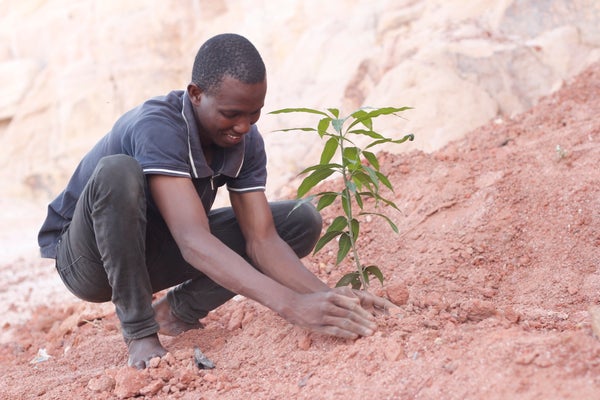This article was published in Scientific American’s former blog network and reflects the views of the author, not necessarily those of Scientific American
A desert is advancing on Nigeria and its neighbors. Each year, the Sahel cuts deeper into the land, overtaking farmlands, rupturing biodiversity and breeding insecurity. In my country, these are the real-world ramifications of climate change happening now. And it is time to fight back—with trees. We must use nature’s basic material (all too often overlooked) for solutions to one of the continent's greatest challenges.
At this year’s United Nations special conference on climate change, I announced the planting of a further 25 million trees in Nigeria. It contributes toward a larger project: a Great Green Wall stretching the breadth of the continent from Senegal to Djibouti. A bulwark against climate change and ecological breakdown, it shall hold back the advancing tide of dunes, restore biodiversity and healthy soils and serve as a great carbon sink—soaking up the CO2 emissions that humans have already released into the atmosphere.
Critically, ecological restoration reduces the threat of land disputes. In the dry season, barren—often drought-stricken—pastureland in the Sahel forces nomadic herders to drive their cattle further south to graze. Here they come into conflict with sedentary farmers, whose numbers have increased with exponential population growth. Two livelihoods—one itinerant, one settled—compete for dwindling resources and clashes break out; vast human and economic costs have been the result. If this ecological breakdown continues unabated, it will only exacerbate this competition for land.
On supporting science journalism
If you're enjoying this article, consider supporting our award-winning journalism by subscribing. By purchasing a subscription you are helping to ensure the future of impactful stories about the discoveries and ideas shaping our world today.
Moreover, these tragedies are not limited to Nigeria, but playing out across the breadth of the Sahel—perhaps the region at the sharpest end of climate change. Nomadic herders are spread across the entirety of this belt. All are being pushed further south in search of water and into conflict with farmers.
Yet climate change is also fomenting insecurity in other indirect ways: it is squeezing opportunity. Over half the population of Nigeria is rural and agriculture is their mainstay. Desertification dries and degrades soil, reducing or wholly destroying yields. Droughts become persistent and food scarce.
With fewer resources to share—less water, less food, less arable land—many are driven through desperation to crime. In the state in which I grew up, cattle raiding, kidnapping and banditry have all grown in severity simultaneously with the weather. Crime shatters business, and a lack of economic hope deepens crime. Breaking this cycle must therefore begin with providing opportunity.
Trees lend a base to build on. They aid water retention in the ground; they shield the land from erosion; and they enrich biodiversity, key for recycling the nutrients in the soil required to grow crops. In the process, they underwrite food security. Fertile land and ecological diversity are the life-support system of these communities. Through enriching them, agriculture is strengthened, jobs are created, and rural development is galvanized.
The logic of planting trees is therefore obvious. Yet the task ahead is great: the Great Green Wall is a project that stretches 8,000 kilometers. The question is how to translate lofty plans into action.
Of course, funding is problematic in the poorest continent on earth. Innovative financing solutions such as sovereign green bonds present a path forward. In 2017, Nigeria became the first African nation to issue one. In June, we issued another, and it was oversubscribed. Fortunately, these initial forays show a clear appetite for this sort of investment, and we are currently working on further issuances.
Second, tree planting must be approached in an organized and methodical way. I grew up in the Sahel region. Around my hometown, forest cover currently varies from a mere 0–1 percent of the land. Yet it would be misguided to suddenly begin planting trees. Instead, we must understand what is feasible. Discounting space for farmland and human settlement, we can increase forest cover to 20–30 percent. It requires assessing what the land can support: which mix of species combines best with a particular area’s soil and climate, one that works with nature’s multiplier effect. Reforesting monoculturally reduces resilience. Diversity, on the other hand, secures a healthy and self-reproducing ecosystem.
Third, a community-driven approach must be adopted. Because climate and conditions differ markedly over not-too-great distances, those who manage the systems should be the community on the frontline: the same people who will benefit from reforestation. We intend to mobilize the youth in the planting, breeding a sense of ownership of their region’s future and strengthening community bonds. For the more we involve everyone in the decision-making processes, the stronger the support for the project.
The time for solely cutting emissions has ended. Sequestering the carbon already in the atmosphere must move to the front of efforts and the best technology we have for this is trees. Nature’s processes can heal what man has wrought. And in acting as a barrier to an encroaching desert, it offers a gateway to collective peace and prosperity across the Sahel.
